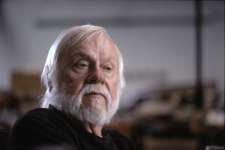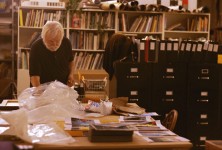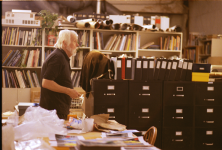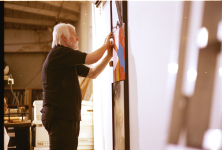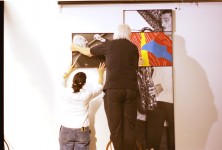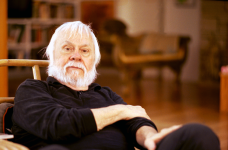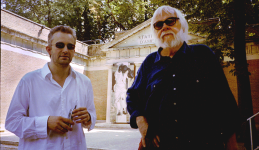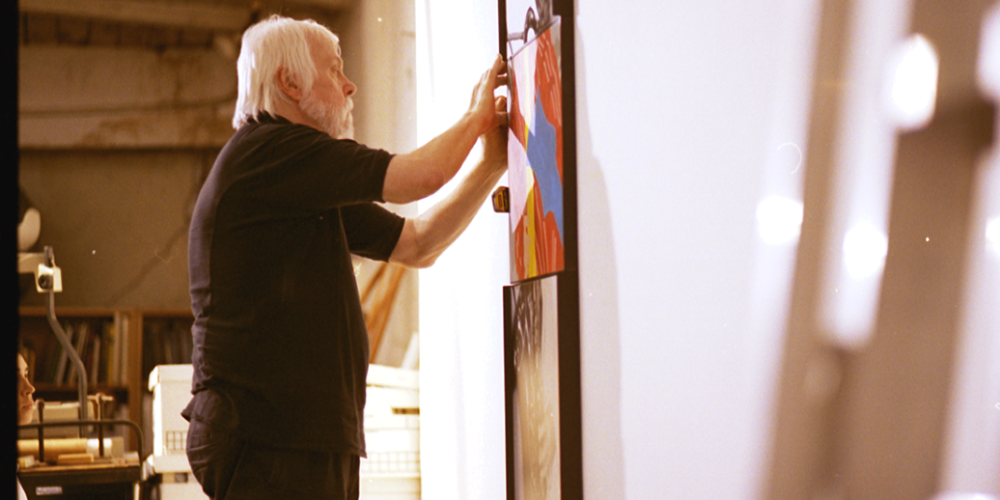
This not That – The Artist John Baldessari
Facts
Art Documentary, 90 min, 2005Directed by Jan Schmidt-Garre
John Baldessari (1931-2020) was born in National City, California. He was based in Santa Monica since 1970. Baldessari was one of the pioneers of conceptual art, which revolutionized contemporary art in the 1960s, and is still a profound influence on young artists today.
The film shows John Baldessari in all aspects of his work: as an artist in his studio, with the technicians he collaborates with, as a teacher interacting with his students, as a passionate observer of the contemporary scene and visiting the Biennale in Venice as well as the Basel Art Fair. The film provides us with insights into the work of a radically modern-thinking artist and sharpens our perception of the often inaccessible world of contemporary art.
These insights are complemented by interviews with his colleagues, students and friends (Meg Cranston, Joseph Kosuth, Matt Mullican, Ed Ruscha, David Salle) as well as with art collectors (Frank Kolodny, Michael Ringier), art dealers (Paula Cooper, Michael Findlay, Victor Gisler, Marian Goodman, Margo Leavin, Philomene Magers) and art historians (David Antin, Dave Hickey, Thomas McEvilley, Coosje van Bruggen).
Beginning with previously unreleased footage from his “Cremation” project and ending with his largest exhibition in the Deutsche Guggenheim in Berlin, the film spans an entire epoch of modern art history.
Cinematography: Thomas Bresinsky
Editor: Gaby Kull-Neujahr
In co-production with ZDF/3sat, SF and Bel Canto Society
Supported by The Andy Warhol Foundation for the Visual Arts, The Broad Art Foundation and Deutsche Bank AG
Press
Brigitte Werneburg, taz, 14.3.2005
Finger auf die Kunst – Das Porträt "This Not That" zeichnet die Konturen des Konzeptkünstlers John Baldessari nach.
Die Eingangsszene lässt das Herz jedes Ikonoklasten höher schlagen: Der Künstler, jung und ungestüm, tritt seine Leinwände ein, trampelt sie kaputt, hackt sie zu Müll. Doch wenige Schnitte später sind sie wieder da, größer, farbenprächtiger und teurer denn je: Museumskunst par excellence. Allerdings, gemalt sind sie nicht. Ihre Motive, schwarzweiße Filmstils und farbige Eingriffe – Konturen, die in Blau, Rot, Gelb, Grün, Violett oder Orange nachgezeichnet sind oder mit diesen Primär- und Sekundärfarben ausgefüllte Figuren – sind auf Kunststoffplatten gedruckt und reliefartig übereinander montiert. Sympathischerweise ist John Baldessari, nun alt und arriviert, selbst über ihre Monumentalität erstaunt, die sie an den Wänden der Deutschen Guggenheim in Berlin haben, für die er sie entwarf.
Die Serie "Somewhere Between Almost Right and Not Quite (With Orange)" beschäftigt sich mit dem Phänomen "Zwischenraum". Im Zwischenraum zwischen der Bildzerstörung von 1967 und der Berliner Ausstellung 2004 siedelt auch Jan Schmidt-Garre seine Dokumentation "This not that: John Baldessari – Pionier der Konzeptkunst" an. Das heißt, auch sie markiert – mit Künstlerinterviews, Kritikerkommentaren und dem Aufsuchen alter Schauplätze – Konturen seines Werks, konzentriert sich dazwischen auf eine ganz bestimmte Werkgruppe und entwickelt so zwanglos Baldessaris Kurs in die Konzeptkunst. Ein eigenständiger Weg von der West Coast, also von Kalifornien aus, wo Baldessari 1931 in National City, geboren wurde, parallel zur New Yorker Fassung Laurence Weiners. Aus dieser Verortung heraus bleibt die visuelle, malerische Spur in Baldessaris Werk vielleicht deutlicher. Die vorgefundenen Fotografien, gern Filmstils, mit denen er nach ersten Textarbeiten experimentierte, tragen immer ein Stück Hollywood in sein Werk.
Auch hier folgt Schmidt-Garre seinem Protagonisten, mit einer sehr filmischen Reise zu einem der Sonntagsmaler, die für Baldessaris "Auftragsbilder" (1969) je eine zeigende Hand malten. Denn so definierte der Künstler Al Held die Konzeptkunst: "Sie begnügt sich damit, auf ein Ding zu zeigen." Damit ist es in einer Dokumentation nicht getan, und so kommt Baldessari selbst zu Wort, das große Vergnügen dieser 60 Minuten zur zeitgenössischen Kunst. In seiner lapidaren Redeweise erklärt er am besten, dass Auswahl, nicht Kunst, das Entscheidende sei. Und so ist es besonders schön, wenn er berichtet, erst kürzlich habe ein Museumskurator zu ihm gesagt, seine Bilder fingen langsam an, wie Kunst auszusehen. "Auf lange Sicht", so Baldessari, "kann man einfach nicht gewinnen."
Quotes
David Antin
"For something to be a cliché it has to have been true once. A cliché is like a pencil that once had a point and its point has been blunted by use to the extent to which it is no longer a useful writing instrument. But if it once was useful, then there is some possibility that you can recover it by placement of it in some odd position. That is, you can retrieve its meaning capabilities in some way. John works within a vein like that."
Releases
On DVD with PARS Media as a limited and numbered edition with many bonus features. Including a second DVD of three previously unpublished films by John Baldessari, signed by the artist (an edition of 120):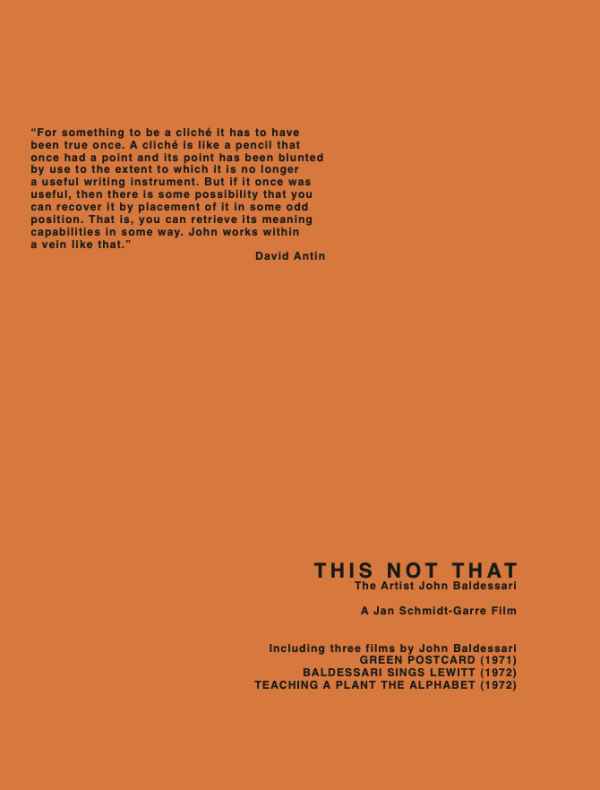
And on DVD as an unlimited edition including many bonus features with Arthaus Musik: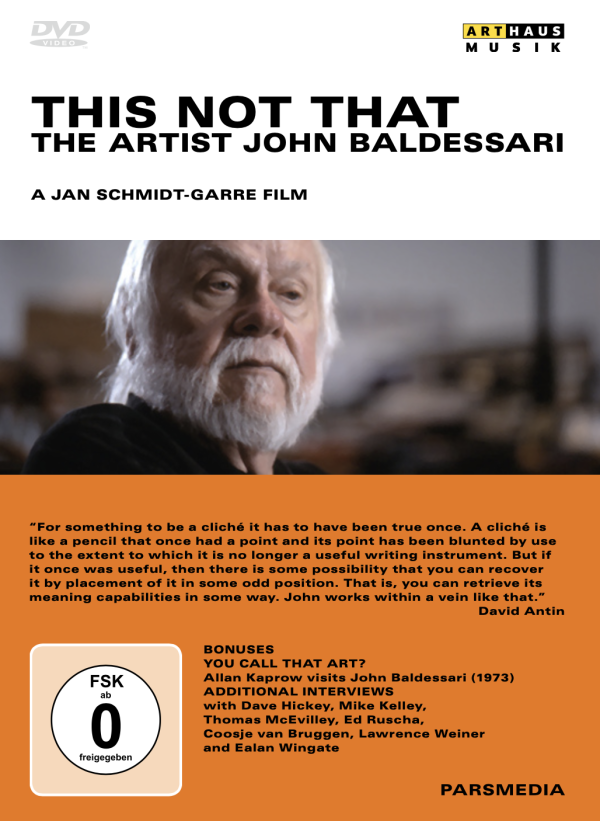
Texts
David Antin: Clichés
For something to be a cliché, it has to have been true once. A cliché is like a pencil that once had a point and its point has been blunted by use to the extent to which it is no longer a useful writing instrument. But if it once was useful, then there is some possibility that you can recover it by placement of it in some odd position. That is you can retrieve its meaning capabilities in some way. John works within a vein like that.
Depicting Pictures
by Jan Schmidt-Garre, first published in Revolver – Zeitschrift für Film, June 2006
German version on waahr.de
How does one best go about showing art in films? It seems easy enough. Whenever a piece of art is discussed it can be intercut, as a reproduction from a catalog or as originally shot footage. The most common procedure is an interview with the artist which is interrupted by images of his work. A second, subsidiary, level is created to illustrate the first.
Why do I refuse to use this convenient way of depicting art in “This Not That” and other films on art and music? Why do I prefer to show works of art in real situations – on a collector’s wall in a room in which something related is going on, at a dealer’s booth at an art fair while that person is being interviewed, or as a picture in a book the protagonist happens to be paging through at the moment?
One reason is that, ideally, every image in a film should have the same degree of importance. Just as Mies van der Rohe, at the onset of the modern era, called for architecture in which the idea of the whole permeated every single element and there was to be no distinction between functional and decorative components or just as Wagner called for musical structure in which all notes were equal and there was to be no distinction between melody and accompaniment, a director who knows his medium will not stand for solving problems in the editing room by cutting to inserts of hands, flower vases or pets, family albums, old buildings or – works of art. In this sense, a film that attempts to be a self-contained work of art should not have any images that are second rate.
But even more difficult than this dogmatic objection is the problem of aesthetic perception. A work of art that is used as an insert becomes evidence that is deciphered. As a moving image in a context, on the other hand, it is experienced. The collector is talking to the artist about his favorite painting and looks at it as he speaks. The film editing process takes that look and cuts to the painting. This simple cut from the beholder to what is being beheld is the essence of the magic of cinema: the audience enters the consciousness of the protagonist through his eyes – the window of the soul – and identifies with him by seeing what he sees, instead of passively being shown what is being talked about. The work of art the collector is looking at is integrated into the narrative flow, it becomes a part of the world of the film instead of just being an image that is made to fit in.
This technique often makes it harder for the director to show the pictures he wants to. Some of the points he wants to make may be less clear and the amount of factual information conveyed in films made this way may very well be less than in most conventional documentaries. As Lessing put it, the poet wants to enable others to “experience sensuous objects”. If the filmmaker succeeds in liberating works of art from their usual status as extras and restores them to their proper roles, they will continue to live on in the minds of the audience – and eventually change their lives.

